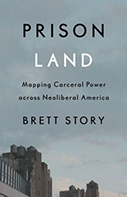Prison Land: Mapping Carceral Power Across Neoliberal America

Author: Brett Story
Publisher: Minneapolis, MN: University of Minnesota Press, 2019. 219 p.
Reviewer: Doris Schartmueller | March 2020
Books about prisons can be written without the author ever stepping inside a correctional institution. This is what Brett Story demonstrates with Prison Land: Mapping Carceral Power across Neoliberal America (2019). Her work details observations made during site visits to different urban and rural locations in the United States. In a beautiful story-telling fashion, Story exposes how punitiveness and mass incarceration in the United States have created and perpetuated systems of inequality far beyond prison walls.
Story approaches the topic of mass incarceration from the perspective of a geographer. Prison Land began as her doctoral dissertation and was also visualized in her documentary The Prison in Twelve Landscapes (released in 2016). Like the film, the book Prison Land provides the audience with insight into the locations of mass incarceration. According to Story, finding answers to the question of where punitiveness happens will contribute to a better understanding of the reasons, the why, that led to its popularity in the first place. In order to expose the many locations of mass incarceration, Story elucidates the prison not merely as a building or a place separated by walls from the rest of society but as a set of relationships. To expose the many marks incarceration has left on our society, Story did not study the prison itself, but rather visited communities and talked to individuals who have been affected—either directly or indirectly—by it. This includes the formerly incarcerated, their loved ones, police and correctional officers, and business owners profiting from punitiveness. While the documentary retells stories of these individuals without commentary, the author chose for her readers a novelistic, picturesque, and creative writing style to share her observations; a style reminiscent of French sociologists Michel Foucault or Loïc Wacquant.
Story also makes it apparent that she wrote this book as an activist informed by penal abolitionism, hoping her work would inform the exploited and oppressed to connect and fight the systems of inequality that constrain them. What primarily spurred her to write this book were penal reforms with the goal of ending mass incarceration that have been launched across the country since 2008. Story begins her book by pondering whether these reforms have dismantled the punitive state or if they have merely redesigned it. What causes her to question the purpose of these seemingly bold penal reforms is that she finds they only seem to revolve around the question of how much punishment is enough without “questioning the very political and effective economy of the prison itself” (p. 102). For Story, the culprit of inequality among these systems in society—of which the prison is a clear manifestation—is to be found in the US political economy. Neoliberalism is built around individual responsibility, an economic system in which success and failure are believed to be self-made. The neoliberal mentality is, she believes, also deeply engrained in the US criminal justice system. She laments that recent penal reforms still treat the “individual criminal subject” as the main problem in communities of distress while crime continues to be considered “the neighborhood’s foremost problem to be resolved” (p. 63). On the other hand, we ignore social relations such as property, wage labor, and race, which are at work in these locations in direct relation to the carceral spaces created by the punitive state all around us.
In an effort to uncover the deficiencies of various recent penal reforms, Story divides her book into five chapters, each one consisting of a separate case study. For each case study, she takes readers to a different location throughout the United States. Her journey starts in Detroit where she calls attention to the recent real estate acquisitions of multibillionaire Dan Gilbert to revitalize the city’s downtown area. She points out that these revitalization efforts have been accompanied by the deployment of an increased number of law enforcement officers and private security guards to protect these new investments. This noteworthy quote from the book describes the neoliberal underpinnings of the punitive state, with “quality-of-life offenses and the criminalization of homelessness through security technology and police powers deployed to displace those deemed inimical to the corporate investment and luxury consumption for which the area is being cordoned off” (p. 38). The revitalization efforts, as Story demonstrates, have been accompanied by increased control and security, which has quickly led to further criminalization of poverty and primarily people of color.
Chapter 2 takes the reader to the city of Brownsville, where the author evaluates the city’s Youth Court and Anti-Violence Project, two programs that have recently been touted as community-based alternatives to incarceration. Instead of seeing these programs as steps toward weakening the punitive state, Story finds that they exemplify the neoliberal logic of money making and are also a vehicle for the management of poverty in urban locations. At their core, these programs involve partnerships of private companies with criminal justice agencies such as police departments and parole agencies. The program participants are primarily people of color, who are threatened with criminal sanctions to remain in the program while businesses profit from their attendance. Furthermore, the neoliberal logic of individual responsibility continues to prevail in these programs, as they work with a “change in people’s habits and choices, rather than in structures, institutions, or power relations” (p. 69).
After these urban locations, Story travels to Kentucky where she visits Appalachian coalfields that have witnessed a major prison construction boom in recent years. Seen as another indication of a community revitalization effort, these prisons have become “commonly pitched as economic development projects and job creation strategies,” because the ”industrial decline and soaring poverty rates render land cheap and residents eager for new forms of employment” (p. 80). Through interviews with correctional officers and other community members profiting from the prison construction boom, the author shows that rural Kentucky struggles with economic development. However, rural Kentucky is just one example of many around the country where prisons are seen as a quick and easy way to create jobs. While interviews help explain the reasons behind the prison construction boom, it remains unclear to the reader how many people were interviewed and what the selection criteria for research participants were. What Story does explain convincingly in this chapter is the short-term thinking behind community revitalization attempts. While a few jobs may be created through building new prisons, more and more people will, in the long term, become isolated from the community through prolonged periods of incarceration and a criminal record that will disqualify them from many jobs.
Chapter 4 takes the reader back to New York, where Story boards a bus that takes families and friends to see their loved ones behind bars each weekend. She considers the prison bus “a carceral space suturing the social fragmentations of prison life” (p. 105). The journey on the prison bus allows Story to gain insight into the loneliness and hardship of incarceration that extends to the many people that care for those behind bars. This chapter stands out, as it exposes the effects that mass incarceration has had on those who are themselves not incarcerated. The bus is primarily occupied by women of color who endure long and uncomfortable rides but want to sacrifice much of their time and money every weekend so they can spend at least a bit of time with their loved ones. Story rides with them on the bus, observing and participating in their conversations. It is also here where a rigorous methodology is missing, however. The author relies on interviews and posts she collects from the online platform Prison Talk but fails to outline how she went about systematically analyzing the interviews and online posts. Furthermore, the conversations she had on the bus did not elaborate on the social and financial hardship the women face due to the frequent bus rides into the most rural corners of the state of New York where the prisons are located.
Finally, in Chapter 5, Story dives into the world of community corrections. Rather than viewing the recent expansion of community-based correctional initiatives as a viable alternative to incarceration, she looks at the reforms critically. By applying neoliberal logic to these programs, she explains that these reform efforts are yet another expansion of the punitive state rather than a retraction. She provides support for this argument by describing several community corrections initiatives in more detail. For example, electronic monitoring has recently been touted as a cost-efficient alternative to incarceration. For Story, however, the “electronic ball and chain” (p. 157) (as she metaphorically names these community corrections efforts) simply expands the power of the state through significant movement restrictions placed on an individual in lieu of incarceration.
With the various stories told in this book, Brett Story succeeds in unravelling the political economy behind punishment by exposing neoliberal underpinnings of the US punitive state that have persisted in recent penal reforms. By pointing to the relationships between property, wage labor, and race, she highlights the many injustices created and perpetuated by capitalist society, how these injustices have pervaded the US criminal justice system, and how the utility of the entire system for society needs to be seriously questioned. Informed by penal abolitionism, her book is also a call for all of us to find solutions for community-based economic inequality, racism, and violence while avoiding involvement of the punitive state. True penal reforms must move away from a neoliberal focus on individual responsibility, holding us all accountable to work toward a liberating future. Despite the methodological shortcomings in several of the chapters, Story’s book adds a deeper understanding of power, inequality, and the role of punishment in the United States, expanding our view of prisons from isolated carceral institutions to systems of punishment permeating today’s society.
Dr. Doris Schartmueller is a faculty member in the Department of Political Science and Criminal Justice at California State University, Chico


